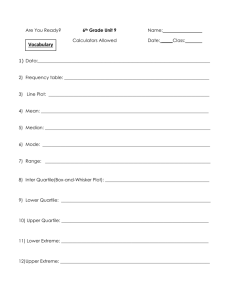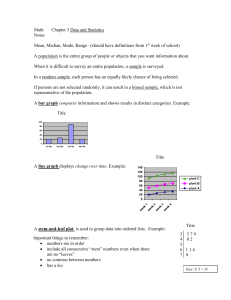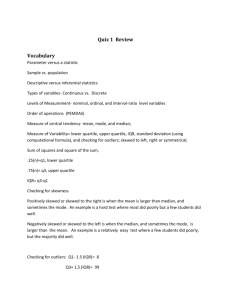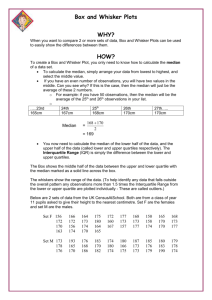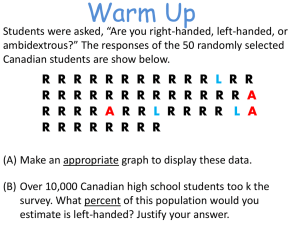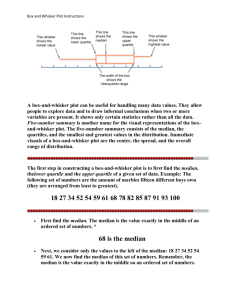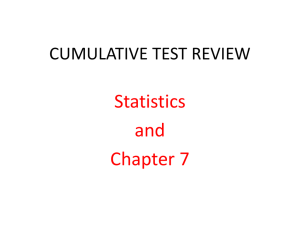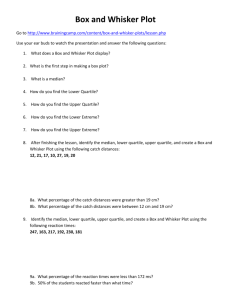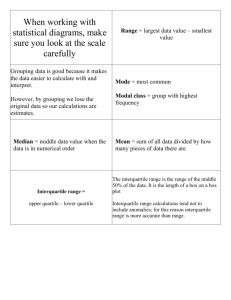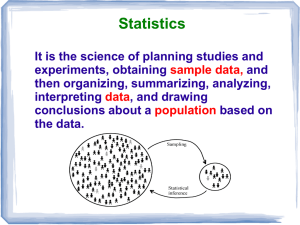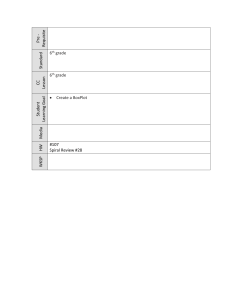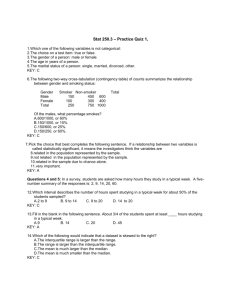Name
advertisement
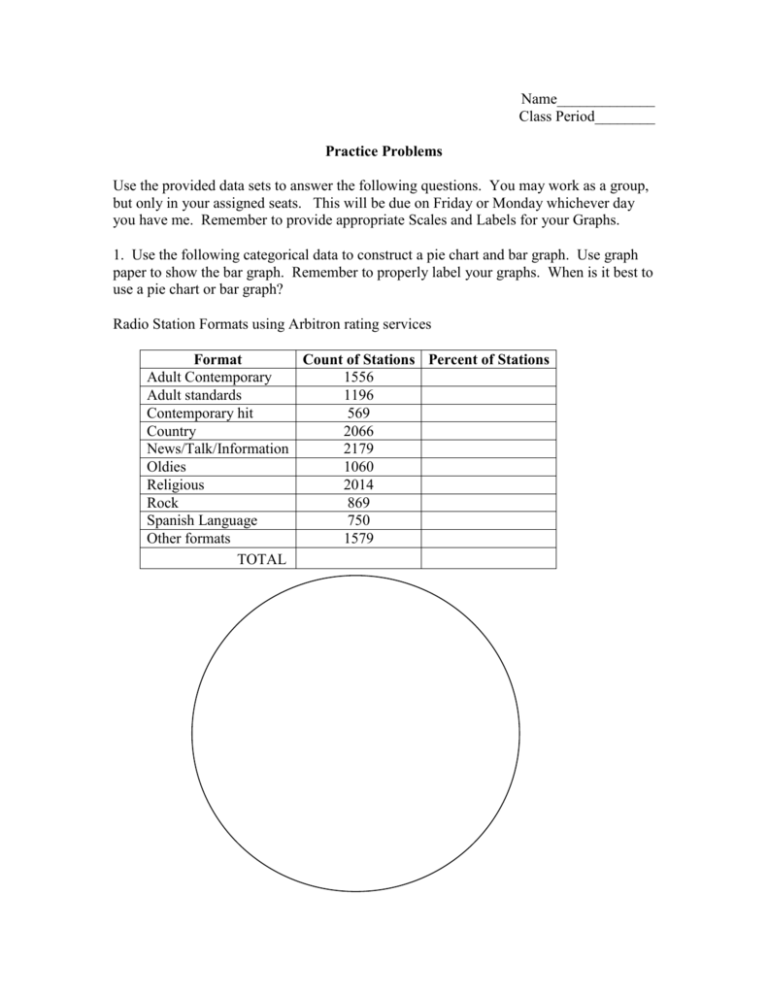
Name_____________ Class Period________ Practice Problems Use the provided data sets to answer the following questions. You may work as a group, but only in your assigned seats. This will be due on Friday or Monday whichever day you have me. Remember to provide appropriate Scales and Labels for your Graphs. 1. Use the following categorical data to construct a pie chart and bar graph. Use graph paper to show the bar graph. Remember to properly label your graphs. When is it best to use a pie chart or bar graph? Radio Station Formats using Arbitron rating services Format Count of Stations Percent of Stations Adult Contemporary 1556 Adult standards 1196 Contemporary hit 569 Country 2066 News/Talk/Information 2179 Oldies 1060 Religious 2014 Rock 869 Spanish Language 750 Other formats 1579 TOTAL 2. IQ test scores for 60 randomly chosen 5th graders 145 139 126 122 125 130 96 110 118 118 101 142 134 124 112 109 134 113 81 113 123 94 100 136 109 131 117 110 127 124 106 124 115 133 116 102 127 117 109 137 117 90 103 114 139 101 122 105 97 89 102 108 110 128 114 112 114 102 82 101 A. Order the data. B. Find the Mean, Median, Mode, and Range of the data. C. Construct a frequency table. D. Construct a dot plot. E. Construct a histogram. F. Construct a stem plot for the data above G. Find the Minimum, Maximum, Median, Upper Quartile, Lower Quartile, and InterQuartile Range (IQR). H. Which graph best describes the data and why did you choose this graph. I am looking for a paragraph here and because it is the easiest is not the right answer. 3. The following table shows the number of births in the United States and the birthrates at 10-year intervals from 1960 to 2000. The birthrate is the number of births per 1000 population. Year 1960 1970 1980 1990 2000 Total Number 4,257,850 3,731,386 3,612,258 4,092,994 4,058,814 Rate 23.7 18.4 15.9 16.7 14.4 A. Order the data. B. Find the Mean, Median, Mode, and Range of the data. C. Construct a frequency table. D. Construct a dot plot. E. Construct a histogram. F. Find the Minimum, Maximum, Median, Upper Quartile, Lower Quartile, and InterQuartile Range (IQR). G. Which graph best describes the data and why did you choose this graph. I am looking for a paragraph here and because it is the easiest is not the right answer. 4. American municipal solid waste in 2000. Material Wt (million tons) Food Scraps 25.9 Glass 12.8 Metals 18.0 Paper 86.7 Plastic 24.7 Rubber, textiles 15.8 Wood 12.7 Yard trimmings 27.7 Other 7.5 A. Order the data. B. Find the Mean, Median, Mode, and Range of the data. C. Construct a frequency table. D. Construct a dot plot. E. Construct a histogram. F. Find the Minimum, Maximum, Median, Upper Quartile, Lower Quartile, and InterQuartile Range (IQR). G. Which graph best describes the data and why did you choose this graph. I am looking for a paragraph here and because it is the easiest is not the right answer. 5. DRP Test Scores: There are many ways to measure reading ability of children. One method is Degree of Reading Power (DRP). The following data is a research study on 3rd grade students. Their scores were 40 47 52 47 26 19 25 35 39 26 35 48 14 35 35 22 42 34 33 33 18 15 29 41 25 44 34 51 43 40 41 27 46 38 49 14 27 31 28 54 19 46 52 45 A. Order the data. B. Find the Mean, Median, Mode, and Range of the data. C. Construct a frequency table. D. Construct a dot plot. E. Construct a histogram. F. Find the Minimum, Maximum, Median, Upper Quartile, Lower Quartile, and InterQuartile Range (IQR). G. Which graph best describes the data and why did you choose this graph. I am looking for a paragraph here and because it is the easiest is not the right answer. 6. Life Expectancy: Most people are aware that life expectancy is much longer now than it was in the past. Here are the numbers for women provided by the National Center of Health Statistics. Year 1900 1910 1920 1930 1940 1950 Life Expectancy 48.3 51.8 54.6 61.6 65.2 71.1 Year 1960 1970 1980 1990 2000 Life Expectancy 73.1 74.7 77.5 78.8 79.5 A. Order the data. B. Find the Mean, Median, Mode, and Range of the data. C. Construct a frequency table. D. Construct a dot plot. E. Construct a histogram. F. Find the Minimum, Maximum, Median, Upper Quartile, Lower Quartile, and InterQuartile Range (IQR). G. Which graph best describes the data and why did you choose this graph. I am looking for a paragraph here and because it is the easiest is not the right answer.
